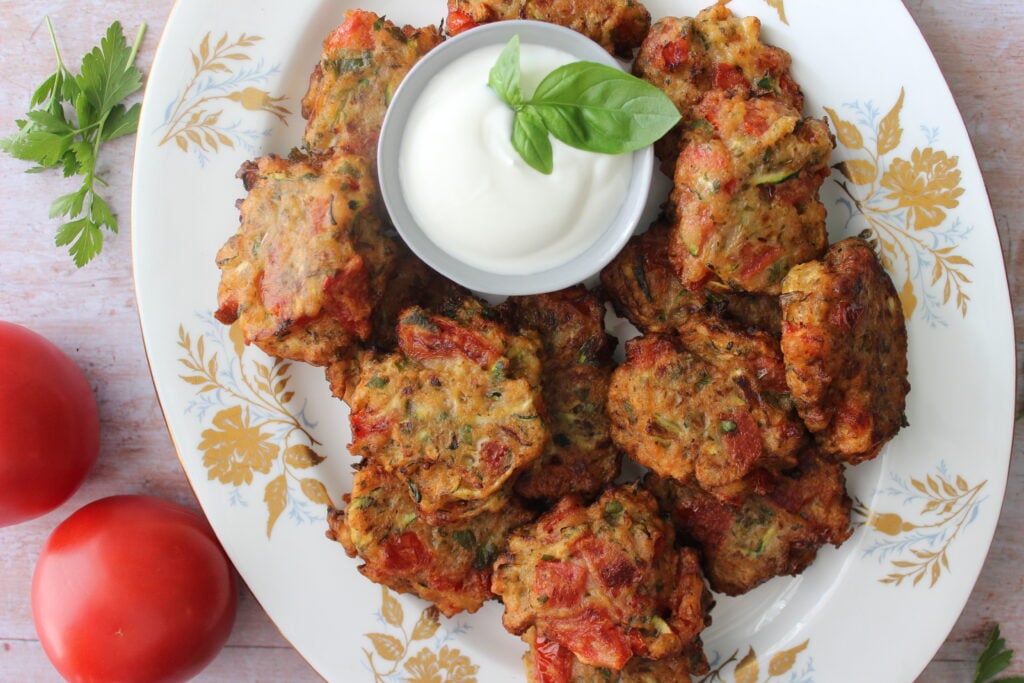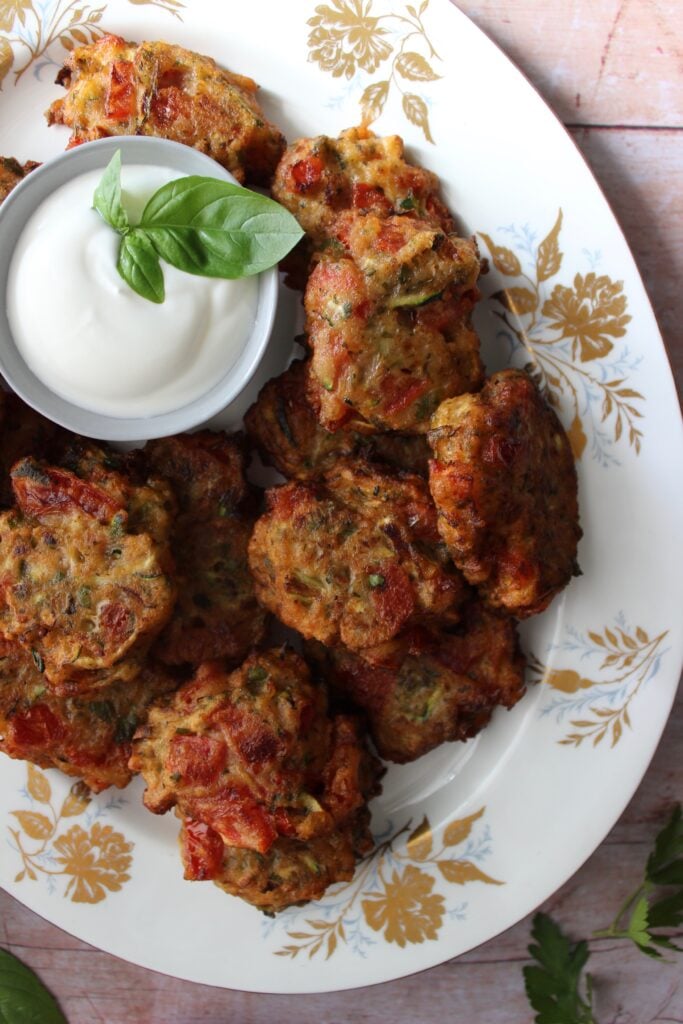Tomato fritters (Ντοματοκεφτέδες)

A Greek meze using all the delicious flavours of summer.
If you’re longing to spend time in Greece but can’t get there this year, these tomato fritters may be the next best thing. Domatokeftedes, as they are called in Greek, are perfect bites of sunshine; an explosion of freshness and herb-y goodness in every bite. A taste of Greece, in the literal sense.
Keftedes actually refers to meatballs (you can find our recipe for Greek meatballs here) however Greek cuisine has a huge repertoire of vegetarian and vegan fritters which are referred to as a composite of their primary ingredient and the word keftedes. An entire array of dishes popularized because they are less expensive to make than anything which is meat based. Also, because they often contain no eggs or dairy they are perfect for periods of lent, and for vegans and vegetarians. It doesn’t hurt that these mezes or appetizers are so easy to eat; two bites and they can be done, your hands free to pick up another.

Our parents have always made all sorts of fritters, some baked, some fried, some with cheese, others without, and all perfectly delicious. You can find many of them by consulting our Recipe List. Domatokeftedes however entered our lives a little later. It all began when one of us took her first trip to Santorini. That idyllic Greek island known for its heart-stopping sunrises, quintessential landscape of white washed houses with sea blue roofs, and its remarkable volcanic setting. Its got some pretty nice beaches too.
When back from paradise, and with Santorini memories still vivid, our parents heard of the amazing domatokeftedes that were enjoyed on the island. About a week later, during a family dinner, the table was set buffet-style and there amidst the tzatziki, the moussaka and the horta was a platter piled high with these tomato fritters. They hadn’t said a word about them but watched on as the lot of us scanned their offerings, our eyes finally settling on this something new.
“Are those domatokeftedes?!” exclaimed the Santorini traveler.
“They are!” our parents proudly responded, in unison.
“I didn’t know you knew how to make these!”
“What do you think? It’s hard? It’s not hard! Now taste, and tell us what you think.”
First taste went to the one of us that had eaten the amazing tomato fritters in Santorini. Eyes closed, mouth slowly chewing and enjoying flavours that brought back a flood of happy moments. Sure, they weren’t quite the same. They weren’t made with the special Santorini tomatoes from the island, and the Greek breeze was not wrapping itself around us as we looked out onto the sea. Instead, when eyes opened, we were in our family kitchen, around a plastic covered table displaying food served on mismatched platters, with our parents waiting expectantly. These domatokeftedes didn’t taste like those in Santorini. They were just a little bit better.


Why are domatokeftedes considered a special dish in Santorini?
The secret is in the tomato! Santorini cherry tomatoes are tiny marvels; so small that you may mistake them for small berries. The unique Santorini climate and geology allows these tomatoes to grow only there, as they have done since the year 1818 when the first seed was reportedly sown by a monk named Fragkiskos at the Capuchins Monastery. Their flavor and texture comes from a combination of things, including the soil which is replete with nutrients from volcanic ash.
Locally referred to as tomataki (or little tomato) their cultivation in Santorini flourished until the 1950s. Along with an earthquake in 1956, the largest threat to the farming of Santorini tomatoes resulted from the very thing that has so many of us falling in love with domatokeftedes in the first place – tourism. As farmers realized that the tourism industry was more lucrative than agriculture, fewer and fewer people devoted their lives and land to farming. Truly unfortunate as these tiny jewels have a slightly dry flesh, an intense aroma and a sweet taste all their own. They are so unique and special that since 2013 Santorini tomatoes have been classified as P.D.O. (Protected Designation of Origin) within the European labeling scheme.


Helpful hints
What type of tomato should we use for these tomato fritters?
Our parents use plum or Italian (also called Roma) tomatoes for these fritters. They do so because they tend to be less juicy than other tomato varieties and the flesh is relatively thick; they hold up quite well in the fritters. To enhance the tomato flavour you’ll note that there is also tomato paste included in the recipe. This enhances the rich tomato flavour and also helps to bind the various ingredients together.
How can we keep the fritters from falling apart in the frying?
It’s important to add the amount of flour required to bind your ingredients together. We use 1/2 cup all-purpose flour but if you feel you need a bit more, go ahead and add more, 1 tablespoon at a time. Go slowly; adding more flour than you need will produce a fritter which can be a bit mushy in the center.
Can I add an egg to help bind my domatokeftedes?
You can, but you really should not have to. We choose to keep these domatokeftedes vegan and they work really well even without the egg for binding. At the same time, you’ll be the one enjoying these, so if you prefer to add an egg, go ahead!
What is the best way to warm up leftover domatokeftedes to eat the next day?
As with most fritters, reheating is tricky. You certainly don’t want to warm them up in the microwave because you will end up with a soggy meze. You can either re-heat them in the oven, or on an un-oiled or dry frying pan. But more importantly…how do you have any left over?

Looking for more delicious fritter ideas? How about these:
Revithokeftedes (chickpea fritters)
Kolokithokeftedes (zucchini fritters)
We love hearing from you! If you have made our recipes, or if you have a question or comment, or simply want to say Hi!, please leave a comment below!


Tomato fritters (Ντοματοκεφτέδες)
Ingredients
- 2 cups seeded and diced plum tomatoes about 4 - 5 tomatoes
- 1 1/4 cups grated zucchini about 1 medium zucchini
- 1/4 cup diced onion about 1/2 a medium onion
- 1 green onion, diced
- 1 tbsp tomato paste
- 2 tbsp chopped parsley
- 4 - 5 fresh basil leaves
- 1 tbsp dry mint or 2 tbsp fresh mint, chopped
- 1 tsp salt
- 1/4 tsp ground black pepper
- 1/2 cup all-purpose flour
- 1 tsp baking powder
- 1 tbsp plain bread crumbs
- olive oil for frying
- plain Greek yogourt or tzatziki for serving optional
Instructions
- Ensure that your diced tomatoes are as "dry" as possible; meaning, you should remove all the seeds, and the pulp that they are found in. If your tomatoes still appear to have a lot of liquid, drain them in a fine sieve.
- Use your hands or a cheesecloth to squeeze out as much liquid as possible from your grated zucchini.
- In a large mixing bowl combine the tomatoes, zucchini, onions (both the yellow onion and the green onion), tomato paste, parsley, basil, mint, salt and pepper. Mix well to combine.
- In a smaller bowl, combine the flour, baking powder and breadcrumbs. Use a fork or whisk to combine well.
- Add the flour mixture to the vegetable and herb mix and stir well to combine. Set aside for 5 to 10 minutes.
- After your mixture has sat for approximately 10 minutes give it another stir. It should hold together when you scoop some of the mixture out with a spoon.
- Heat approximately 1 - 2 centimeters of olive oil in a pan over medium heat (we like to use a non-stick pan).
- Use two spoons (we use tablespoons) to portion out the mixture for the fritters. Use the first spoon to scoop out the mixture and the second spoon to help shape it and to then slide it off the first spoon into the hot oil.

- Fry for 2 - 3 minutes until golden brown and then use two forks to flip your fritters over. Press down slightly and fry for an additional 2 - 3 minutes until golden brown on both sides and cooked through.
- Remove from the oil and drain on a paper towel lined plate. Allow to cool and then serve with a side of plain yogourt or tzatziki.
- Enjoy!


You are fantastic thank you every recipe you put i love.
Thank you so much 🙂